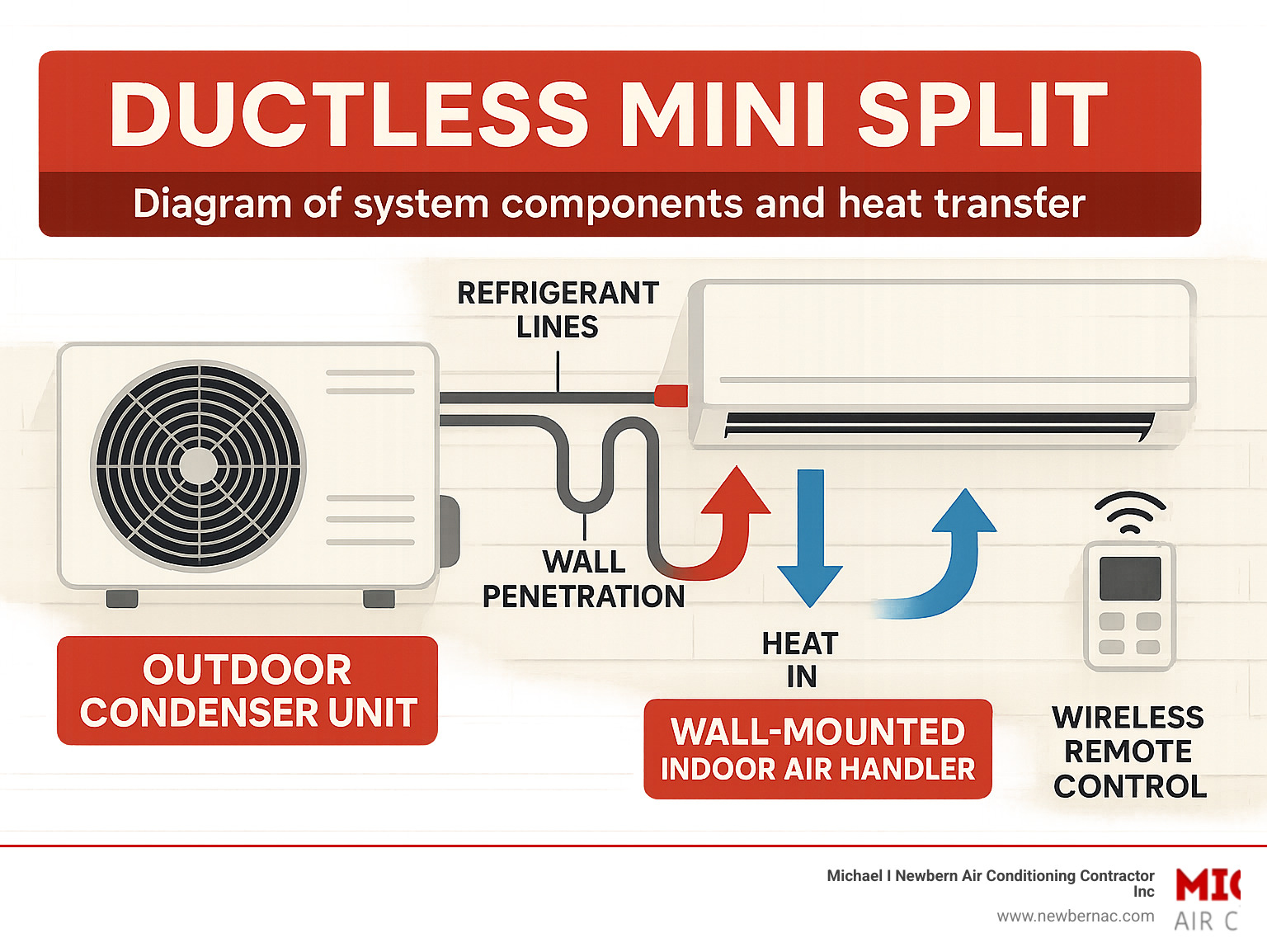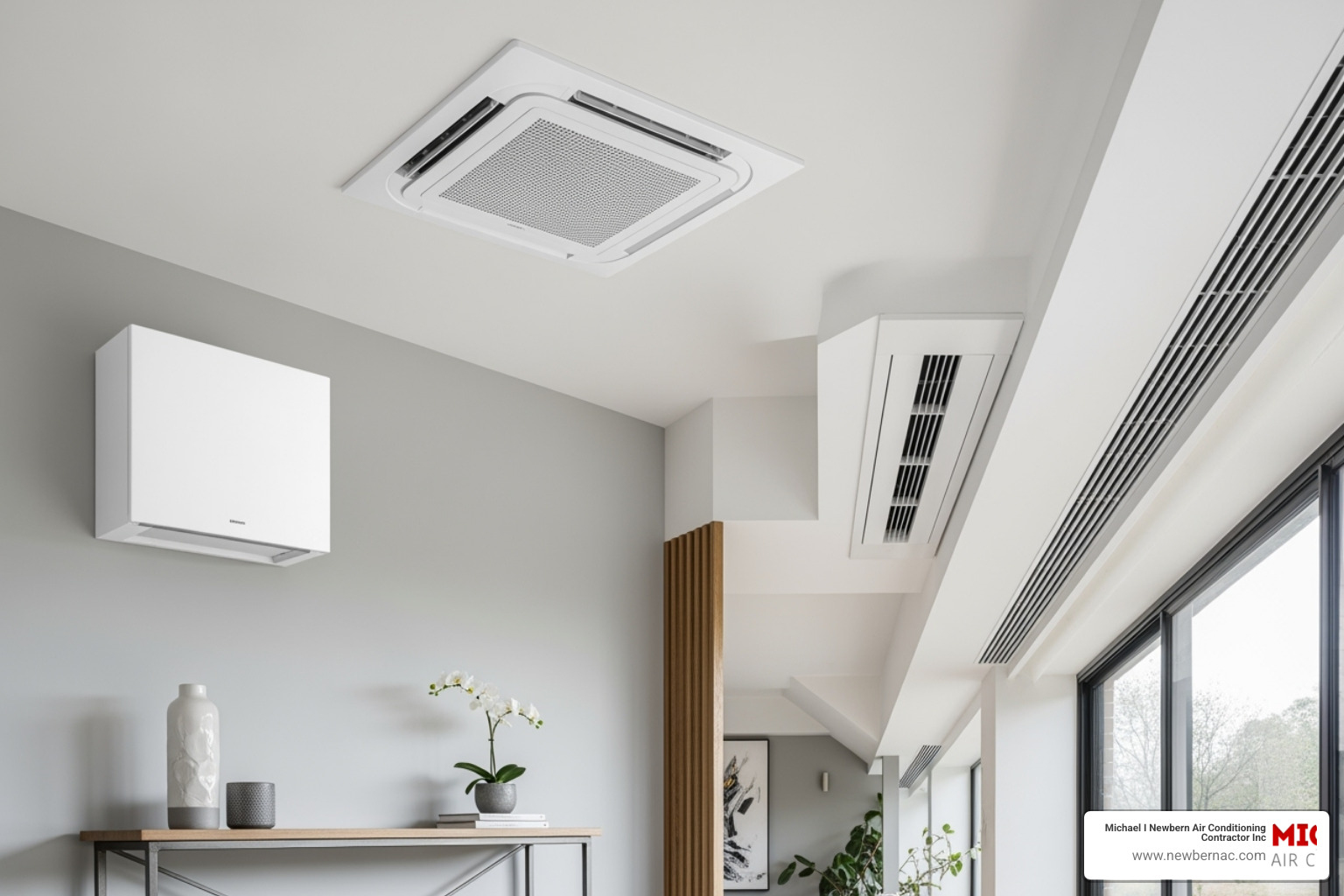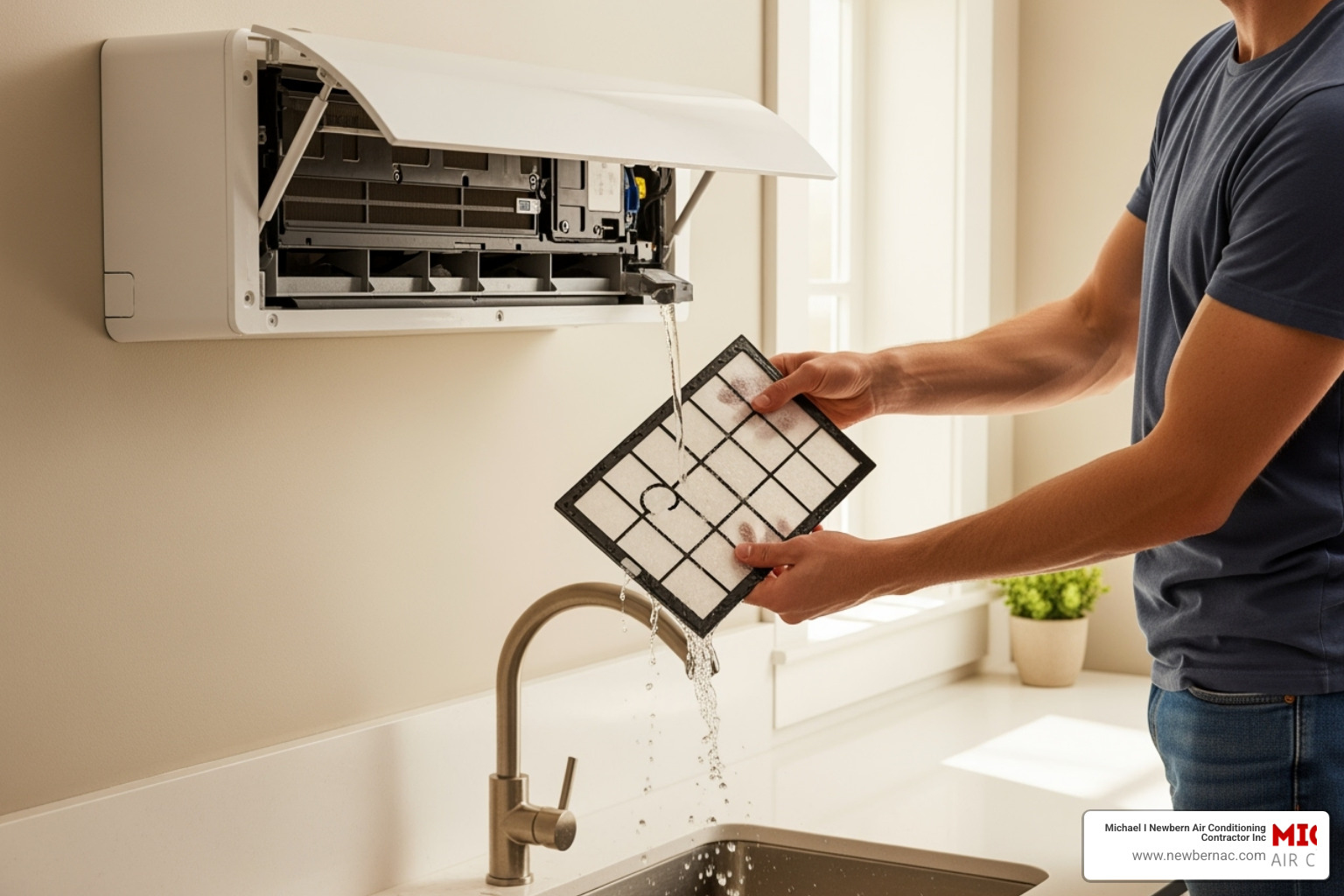Why Ductless Mini Splits Are Revolutionizing Home Comfort
A ductless mini split is a highly efficient heating and cooling system with an outdoor compressor unit connected to one or more indoor air handlers via refrigerant lines, eliminating the need for traditional ductwork.
Key Features of Ductless Mini Split Systems:
- Two main components: Outdoor condenser unit and indoor air handler(s)
- Energy efficient: No ductwork means no energy loss (up to 30% savings)
- Flexible installation: Requires only a small 3-inch wall hole
- Zone control: Individual temperature settings for different rooms
- Dual function: Provides both heating and cooling year-round
- Quiet operation: Indoor units operate as low as 22dB(A)
If you’re dealing with hot spots, planning a room addition, or replacing an old HVAC system in your Central Florida home, ductless technology is a popular modern solution.
These systems use inverter technology and variable-speed compressors for precise temperature control, using far less energy than traditional central air. The absence of ductwork alone eliminates energy losses that can account for more than 30% of energy consumption in conventional systems. For Florida homeowners, ductless mini splits are ideal for handling our climate while cooling specific areas without installing new ductwork.
How Ductless Systems Work and Key Components
A ductless mini split system bypasses the need for extensive ductwork by using a direct connection between an outdoor unit and one or more indoor units, making them highly efficient and versatile.
Operating on heat pump technology, a ductless mini split can both heat and cool your home. In cooling mode, it absorbs heat from inside and releases it outdoors. In heating mode, it reverses the process, extracting heat from the outdoor air and transferring it indoors. This year-round capability makes them an excellent choice for Central Florida’s climate.
The heat transfer occurs through small refrigerant lines that run between the units. Unlike bulky ductwork, these lines only require a small, three-inch hole through a wall, making installation much less intrusive.
A key advancement is inverter technology. Traditional HVAC systems cycle on and off, causing energy spikes and inconsistent temperatures. Inverter technology allows the compressor to adjust its speed to match the exact demand, resulting in improved energy efficiency, quieter operation, and more stable room temperatures.
To understand more about how these systems can benefit your home, explore our detailed information on Ductless Mini Split Systems.
The Outdoor Unit (Condenser/Compressor)
The outdoor unit is the powerhouse of the ductless mini split system, containing the compressor and condenser coil where heat exchange occurs. It pressurizes the refrigerant and either releases heat outside (cooling) or absorbs it from the outside (heating).
Modern ductless mini split outdoor units are remarkably quiet. Thanks to advanced engineering and inverter technology, they run much more quietly than traditional central air conditioners, causing less disturbance for you and your neighbors.
The Indoor Unit (Air Handler/Evaporator)
The indoor unit, or air handler, distributes conditioned air directly into your living space. These sleek units are typically wall-mounted, though other styles are available. Inside, a quiet blower fan circulates air over a coil to deliver heating or cooling.
Indoor units have filters to improve air quality by trapping dust and other particles. Most models include a remote control for adjusting temperature, fan speed, and modes. Each indoor unit can be set to a different temperature, allowing for customized comfort in different rooms. If you’re having issues with your unit, such as it blowing warm air, we have resources to help you Stop Mini Split from Blowing Warm Air.
Ductless Mini Split vs. Central Air Conditioning
When choosing a comfort system for your Central Florida home, you’ll likely compare ductless mini split systems with traditional central air conditioning. They work differently, which impacts comfort, energy bills, and installation.
Let’s break down how these two systems stack up:
| Feature | Ductless Mini Split | Central Air Conditioning |
|---|---|---|
| Installation | Minimal disruption, small wall penetration, no ductwork. | Extensive ductwork installation required, more invasive. |
| Energy Efficiency | Highly efficient due to no duct losses; variable speed. | Significant energy loss (up to 30%) through ductwork. |
| Zoning | True zone control with individual indoor units. | Limited zoning, often cools entire house to one temp. |
| Aesthetics | Indoor units are visible; various styles available. | Ducts are hidden; vents are visible. |
The biggest game-changer with ductless mini split systems is the elimination of energy waste. With central air, cooled air travels through ducts in hot attics or crawl spaces, losing up to 30% of its energy. A ductless mini split delivers conditioned air directly into the room, preventing this loss and boosting efficiency.
For Florida homeowners, especially those in older homes without existing ductwork or those planning additions, ductless mini splits provide modern comfort without a major, expensive construction project.
Energy Efficiency and Zoning Flexibility
Ductless mini splits excel at creating personalized comfort zones. Instead of cooling the entire house to one temperature, you can cool only the rooms you’re using, which is far more energy-efficient.
Variable-speed compressors adjust their output to meet each room’s specific needs, reducing energy consumption. Since there are no ducts, you don’t lose conditioned air to leaks. For more information on energy savings, check out the Ductless Heating & Cooling resources from ENERGY STAR.
Installation and Home Suitability
The installation for a ductless mini split is much simpler than for ducted systems. It requires only a small wall penetration—typically three inches in diameter—to connect the indoor and outdoor units.
This minimal construction makes ductless mini splits ideal for non-ducted homes, room additions, or converting spaces like garages and attics. This approach adds modern comfort while preserving your home’s aesthetics, as you avoid bulky ductwork and large vents.
If you’re considering ductless mini split technology, our team can help. Learn more about our professional Ductless Mini Split Installation services.
Choosing the Right System for Your Home
Finding the perfect ductless mini split for your Central Florida home involves understanding your space, comfort needs, and our unique climate. Key factors include energy efficiency ratings, system sizing, voltage requirements, and indoor unit styles. Getting these details right ensures your system performs beautifully for years.
For homeowners who want to dive deeper, we’ve put together a guide on Mini Split Sizing and Placement.
Understanding Energy Efficiency Ratings
When shopping for a ductless mini split, you’ll see several key ratings that indicate how much you can save on energy bills.
- SEER (Seasonal Energy Efficiency Ratio) measures cooling efficiency over an entire season. In Florida, a higher SEER rating means significant savings.
- EER (Energy Efficiency Ratio) shows how well the system performs at peak temperatures, like a sweltering 95°F afternoon.
- HSPF (Heating Seasonal Performance Factor) measures heating efficiency during our cooler months. A higher HSPF means your system warms your home efficiently.
Higher ratings mean more than just energy savings; these systems also tend to run quieter, maintain more consistent temperatures, and last longer. Look for the ENERGY STAR® certified products label for systems that meet strict efficiency guidelines.
How to Choose the Right Ductless Mini Split System
Choosing your ideal ductless mini split system starts with deciding if you need to cool a single area or multiple zones.
- Single-zone systems are perfect for one specific area, like a home office or a converted garage. They pair one outdoor unit with one indoor unit for targeted comfort.
- Multi-zone systems provide whole-home comfort by connecting one outdoor unit to multiple indoor units, each with its own temperature control. This allows you to cool the living room for movie night while keeping an unused guest room warmer.
The style of indoor unit also impacts your home’s appearance. Wall-mounted units are popular and sleek. Ceiling cassette units are nearly invisible and distribute air in four directions. Slim duct units are hidden completely within walls or ceilings.
Room size calculation is critical. It considers not just square footage but also ceiling height, insulation, and window exposure. This is where professional consultation is invaluable. A proper load calculation ensures your ductless mini split works efficiently and effectively for years.
Lifespan and Maintenance Requirements
A ductless mini split system is a smart investment for long-term comfort, typically providing 15-20 years of dependable heating and cooling when properly maintained. Regular upkeep is key to maximizing its lifespan and efficiency.
Without proper care, you might notice reduced airflow, unusual noises, or inconsistent temperatures. Fortunately, most maintenance is simple, and catching problems early can save you money and discomfort.
If you’re experiencing temperature issues, our guide for Mini Split Temperature Issues can help.
Routine Maintenance for Your Ductless Mini Split
You can perform most routine maintenance yourself in just a few minutes each month.
Cleaning your filters is the most important task. These washable filters trap dust and debris. When dirty, they force the system to work harder, increasing energy bills and reducing comfort.
Simply slide the filters out, wash them with soapy water, let them air dry, and slide them back in. We recommend doing this every few weeks during heavy use.
Also, keep your outdoor unit clear of leaves, grass, and debris to ensure proper airflow, maintaining at least a foot of clear space around it. Finally, check that the condensate drain line from the indoor unit is flowing freely to prevent water damage.
If you still have issues after cleaning filters, our guide on Mini Split Airflow Problems offers more solutions.
Professional Servicing and Repairs
While DIY care is crucial, we recommend an annual check-up with a qualified HVAC technician for tasks that require a professional touch.
During a professional visit, a technician will:
- Check refrigerant levels for optimal performance.
- Inspect electrical connections for safety and tightness.
- Perform a professional coil cleaning to restore efficiency.
- Examine the drainage system for blockages.
- Run diagnostic tests to verify all components are working correctly.
Regular professional maintenance protects your warranty and catches small issues before they become major problems. When repairs are needed, our team offers comprehensive Mini Split Repair services.
Frequently Asked Questions about Ductless AC
Homeowners often have questions when first learning about ductless mini split systems. Here are answers to the most common ones we hear.
Can a mini-split heat my home in the winter?
Yes, most ductless mini splits are heat pumps, providing both cooling in the summer and heating in the winter. Instead of creating heat, they efficiently move it from the outdoor air into your home, even on chilly days. This dual functionality provides year-round comfort from a single, energy-efficient system, which is ideal for Central Florida’s climate.
Are ductless systems noisy?
No, ductless systems are known for their quiet operation. Indoor units can run as quietly as a whisper (as low as 22 decibels), and the outdoor unit is typically much quieter than a traditional central AC condenser. Because they use inverter technology to run consistently at low speeds, they avoid the jarring startup and shutdown sounds of older systems.
How many rooms can one system cool?
This depends on the system type. A single-zone system is designed for one specific area, like a room addition or home office, connecting one indoor unit to one outdoor unit. A multi-zone system connects a single outdoor unit to multiple indoor units (often up to five), providing customized temperature control in several different rooms. This allows you to set different temperatures in different zones, saving energy by only conditioning the spaces you’re using.
Your Partner for Ductless Comfort in Central Florida
When you’re ready to upgrade your home’s comfort with a ductless mini split system, you need a partner who understands the technology and our local Central Florida climate.
Ductless mini split technology offers incredible energy savings, personalized comfort through zone control, and a modern HVAC solution. Whether you’re fixing a problem room, planning an addition, or upgrading an old system, these units deliver results that traditional systems can’t match.
At Michael I Newbern Air Conditioning Contractor, Inc., we’ve helped Central Florida families stay comfortable for over 30 years. With thousands of satisfied customers in Auburndale, Haines City, and Davenport, we know how ductless mini splits perform in our climate and how to optimize them for your home.
Our team guides you through every step, from the initial assessment and system sizing to professional installation and ongoing maintenance. We ensure you have the information needed to feel confident in your decision.
Ready to experience personalized comfort? We can help you open up the full potential of ductless mini split technology for your home. From expert installations to reliable maintenance and repairs, you’ll find all our services at Ductless Mini Split Services. Let’s work together to create the comfortable, energy-efficient home you deserve.




